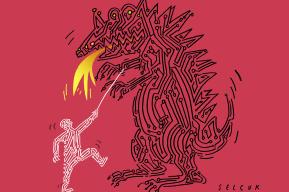观点
不断移动的边界,看不见但却非常真实

今天,边界不再一定是由砖块和铁丝网构成。它们正日益成为不断移动的屏障,依靠尖端科技和复杂法规对公民实施旅行限制。COVID-19大流行让这一现象更显突出。
阿耶莱特·沙哈尔
(德国哥廷根马克斯•普朗克宗教与族群多样性研究所所长,最新著作是《不断移动的边界:人口移徙和流动的法律制图》。)
1989年,随着柏林墙的倒塌,许多人预言,封闭的大门将很快成为过往时代的遗迹。而今天,我们所面临的现实却并非如此。边界不但没有消失,还变化出了新的形态。边界本身已经成为一种移动的屏障,一种无锚可定的法律结构。它脱离了地图的拘囿,可以随意延伸到领土边缘之外或深入领土腹地。国家权力与固定地理标志的彻底解绑让一种新的范式应运而生:不断移动的边界。
不断移动的边界在时间和空间上都是不固定的,它由法律门户而非物理屏障组成。应对当前这场全球大流行病的措施加速了这一趋势。
2020年1月,当中国武汉出现一批不明原因病毒性肺炎病例时,曾在严重急性呼吸系统综合征(SARS)和中东呼吸综合征(MERS)疫情中饱受冲击的亚洲邻国没有浪费时间。除了采取公共卫生应对措施外,这些国家还出台了限制入境的旅行禁令。
现在,入境管制措施在距离本国边境千里之外的国外中转枢纽就可以实施。以加拿大为例,该国规定,凡出现COVID-19症状者(包括加拿大本国公民),一律禁止登上飞往加拿大的飞机。通过此举,该国在概念上和法律上都向外拓展了边界——将其边境管制活动转移部署到海外口岸,主要是在欧洲和亚洲。
科幻小说般的现实
值得注意的是,根据2020年5月最新统计,已有近200个国家通过禁止出入境旅行实施了这种旅行限制。在危机最严重的时候,为应对COVID-19而出台旅行限制的国家人口总数占到全球人口的91%。实施这些法定入境禁令(在一些国家还有出境禁令),甚至都不需要往领土边界地区派遣一兵一卒或是搬运一袋水泥。取而代之的是,各国政府只需改变边界,即可实现人口流动管制,具体来说,就是在旅客登机前加以阻止,或是在旅客抵达目的地之后进行管制,例如要求抵境旅客佩戴GPS腕带。据旅游行业专家表示,相比之下,个人可能更愿意在母国完成预隔离观察。
在研制出疫苗之前,人口流动和移徙管理显然将会发生深刻变化。科幻小说中的情节现在已成现实。向来以安检严格著称的以色列本古里安机场目前正在开发一种不需要任何人工服务的“无缝”值机流程,其目标是创建“无冠状病毒的交通枢纽”和隔离式“区域”或“气泡”,进而在这些区域内实现旅行的畅通。只有健康的人才能获准出入这些“无菌”走廊。
这些事态发展引发了重大的道德和法律争议。健康将成为无价之宝,也就是出外旅行的一个先决条件。智利、德国、意大利和英国等国家目前正在探索“免疫护照”这个概念——允许持免疫护照者参与公共生活、自由流动,同时从各方面限制无免疫护照者的活动。
智能隧道和生物识别边界
其实早在这场大流行病暴发之前,各国政府就已经越来越依赖生物识别技术来进行人口移徙监管,这为监控和追踪各个地方每个人的流动情况提供了前所未有的技术“透视眼”。
随着大数据的兴起和记录旅客生物识别信息的庞大数据库的建立,生物识别边界不断扩展,我们的身体将成为我们的通行证。在这方面,引领潮流的是澳大利亚、中国、日本、美国和阿拉伯联合酋长国等国家。迪拜国际机场推出了一个新的“生物识别边界”试点项目,名为“智能隧道”,即通过扫描使用者的虹膜和面部来识别乘客。
要实现这一奥威尔式的愿景,必须重新定义边界的位置、运行和逻辑,让各国政府或其代表能够更早、更频繁、更远距离地对旅客进行筛查和拦截。这样一来,只要旅客在过程中通过多个检查点,就可以随时随地被追踪。
欧盟当前为实现人口移徙和流动管理而采取的一个步骤是,在欧盟境内强制实施“电子旅行授权”制度,适用对象甚至包括那些享受免签证旅行资格及持有人人羡慕的国际通用护照的人员。欧洲旅行信息和授权系统(ETIAS)将于2022年启动,并作为申根地区所有26个国家入境旅客旅行前授权的信息交流中心。
这个额外的信息收集层与旅客护照相关联,形成一道强大而无形的移动边界,这道边界可以在世界任何地方运行,于旅客出发之前启动,并根据旅客的位置和风险状况进行自我调整。
我们每个人身上都有一道边界
其他项目还为人口流动监管增加了些许未来色彩,例如由欧盟资助的名为 iBorderCtrl的试点项目(一个过境安全检测系统)。按照规定,入境旅客必须“与虚拟形象进行一次简短、自动、非侵入性的面谈,并接受测谎仪检测。”然后,相关数据会被存入大型互连数据库——当局可利用这些数据“计算出每个人的累积风险系数”。
该风险系数在旅客今后通过任何过境点时都会被读取,可能会导致旅客接受进一步检查,甚至被拒入境。iBorderCtrl虚拟形象经过训练,可以通过寻找“微手势”来检测人类的欺骗行为。类似的研制成果可能很快就会在美国投入运行。在美国,由人工智能驱动的筛查系统可以追踪血液流动变化或细微的眼动变化。因此,曾经固定的边界不仅在不断移动,而且还在倍增和分裂。每个人实际上都随身“携带”着边界。
这些事态发展对权利和自由的范围产生了巨大影响。将人的身体视为监管的场所,这已不再是各国政府的专属权限。各大科技公司也在大力参与对病毒检测呈阳性者的数据挖掘和地理定位(有时甚至不经当事人同意)。
但此次危机同样向我们表明,另一种未来触手可及。为应对这场大流行病,葡萄牙政府宣布,凡已身居葡萄牙领土之上的移民(包括寻求庇护者),一律与本国公民享有同等的“卫生保健权、社会保障权以及就业和住房稳定权,这是危机时期一个团结社会应予承担的责任”。这种同时同地分担同样风险的姿态既浇灌出了友谊之花,也筑起了共同体的大厦。
如果有一天,我们找到了治疗这种致命病毒的更好方法,届时,我们将面临另一项任务,那就是消除病毒所带来的恶劣的、排他性的影响。
拓展阅读:
《硬币的另一面》,联合国教科文组织《信使》,2019年4-6月刊
《非洲人才流失:可有化解之策?》 ,联合国教科文组织《信使》,2018年1-3月刊
《欧洲要塞欢迎你》,联合国教科文组织《信使》,2001年9月刊
订阅联合国教科文组织《信使》,获取最新资讯和评析,数字版免费。
在社交网络上关注联合国教科文组织《信使》:微博、微信公众号“联合国教科文信使”、Twitter、Facebook、Instagram。
图片:Noelle Mason
By Ayelet Shachar
In 1989, with the fall of the Berlin Wall, many predicted that sealed gates would soon become relics of a bygone era. Today, we find a different reality. Instead of disappearing, borders are metamorphosing. The border itself has evolved to become a moving barrier, an unmoored legal construct. It has broken free of the map; it may extend beyond the edge of territories or into their interiors. The unmooring of state power from any fixed geographical marker has created a new paradigm: the shifting border.
The shifting border is not fixed in time and place; it consists of legal portals rather than physical barriers. Responses to the global pandemic have accelerated this trend.
In January 2020, when a cluster of mysterious viral pneumonia cases struck in Wuhan, China, neighbouring Asian countries – that had already borne the brunt of the SARS and MERS outbreaks – wasted no time. In addition to public health responses, they introduced travel bans that restricted access to their territories.
Regulation of entry can now happen in foreign transit hubs, located even thousands of miles away. In Canada, for instance, anyone – including its citizens – presenting with COVID-19 symptoms were barred from boarding a Canada-bound plane. With this move, the country stretched its borders outwards both conceptually and legally – relocating its border-control activities to overseas gateways, primarily in Europe and Asia.
A science-fiction reality
Remarkably, on the latest count (May 2020), nearly 200 countries have imposed such travel restrictions by banning inbound and outbound travel. At the height of the crisis, ninety-one per cent of the global population were living in countries that had introduced travel restrictions in response to COVID-19. None of these legally mandated bans on entry (and in some countries, exit) required even one battalion of soldiers to move to the edge of the territory, or a single sack of cement to be placed at the border. Instead, governments shifted the border to regulate mobility by blocking travellers before they embark, and even after they reach their destination – by being told to wear GPS wristbands, for example. Experts in the travel industry have suggested that individuals may prefer to pre-quarantine in their home countries.
Until a vaccine is developed, it is clear that the management of mobility and migration will be deeply altered. What resembled science fiction is now a reality. Israel’s Ben-Gurion airport, already known for its strict security protocol, is now in the process of developing a “seamless” check-in process, whereby no human agent is involved. The goal is to create “coronavirus-free transportation hubs” and insulated “zones” or “bubbles” in which travel will resume. Only the healthy will be permitted through these “sterile” corridors.
These developments raise significant ethical and legal dilemmas. Health will become an invaluable asset, a prerequisite to travel. Countries including Chile, Germany, Italy and the United Kingdom are exploring the idea of “immunity passports” – granting access to public life and mobility for some, while reducing it for others.
Smart tunnels and biometric borders
Even prior to the pandemic, governments were increasing their reliance on the biometric regulation of migration – which provides unprecedented technological “see-all” eyes to monitor and track everyone’s mobility everywhere.
With the simultaneous rise of big data and the creation of vast databases that record biometric information of travellers, our bodies will become our admission tickets as biometric borders expand their reach. Countries including Australia, China, Japan, the United States, and the United Arab Emirates are leading the way. Dubai International Airport has introduced a pilot of new “biometric borders”– known as smart tunnels – that identify passengers through scans of a user’s iris and face.
To achieve this Orwellian vision, the location, operation, and logic of the border have to be redefined to allow governments or their delegates to screen and intercept travellers earlier, more frequently, and more distantly. Thus, travellers are tracked as they move through multiple check-points along the travel continuum.
As part of the effort to achieve migration and mobility management, an “electronic travel authorization” will now be required for the European Union – even for those who benefit from visa-free travel and are in possession of internationally coveted passports. The European Travel Information and Authorization System (ETIAS), to be launched in 2022, will serve as a clearing-house for pre-travel authorization for visitors to all twenty-six countries in the Schengen area.
Linked to their passports, this additional layer of information-gathering creates a powerful yet invisible shifting border that is operational anywhere in the world – prior to departure, adjusting itself to the location and risk profile of the traveller.
A border in each of us
Other projects, such as the EU-funded pilot project called iBorderCtrl, add futuristic dimensions to mobility regulation. Incoming travellers are required to “perform a short, automated, non-invasive interview with an avatar [and] undergo a lie detector.” The data is then stored in large interconnected databases – allowing authorities to “calculate a cumulative risk factor for each individual.”
The calculated risk factor will appear in any future border crossing and may lead to further checks, or even a denial of entry. The iBorderCtrl avatar is trained to detect human deception by looking for “micro-gestures.” Similar developments may soon be operational in the US, where AI-powered screening systems can track changes in blood flow or subtle eye ticks. The once-fixed border is thus not just shifting, but also multiplying and fracturing. Each person effectively “carries” the border with them.
These developments bear dramatic implications for the scope of rights and liberties. Treating the body as the site of regulation is no longer solely a purview of national governments. Major tech companies are heavily involved in data-mining and geolocating those who have tested positive for the virus (sometimes without consent).
But the very same crisis has shown us that another future is within reach. In response to the pandemic, the Portuguese government declared that all immigrants already on its territory – including asylum seekers – would gain access to the same rights as citizens to “health, social security, and job and housing stability as a duty of a solidarity society in times of crisis.” Here, sharing the same risks, in the same place, at the same time, created camaraderie and community.
When the day comes that we can better treat this deadly virus, we will be left with the task of undoing its harsh, exclusionary impacts.
Ayelet Shachar
Director at the Max Planck Institute for the Study of Religious and Ethnic Diversity, in Göttingen, Germany. The Shifting Border: Legal Cartographies of Migration and Mobility is her most recent book.









